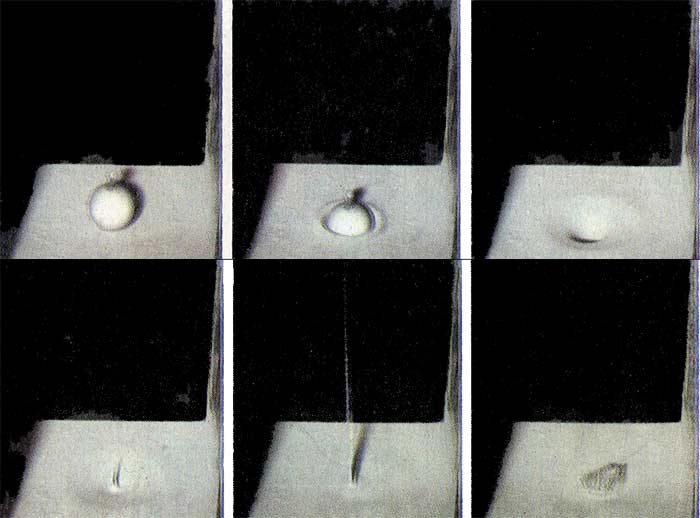Experiments in the Laboratory
Beware! Sand in the Physics Lab May Eat You AliveWhen I was a little kid we had a sand box. It was a quicksand box. I was an only child... eventually. - Steven Wright
Click to Play
by Kenneth Chang Beware of playing in any sandboxes you might find in the laboratory of Dr Detlef Lohse. Traditional deathtrap quicksand is a slurry of sand, water and clay. The water keeps the sand from sticking together to support weight, and a person who steps in slowly sinks. Now Dr Lohse, a professor of applied physics, and his colleagues at the University of Twente in the Netherlands show that it is possible to vanish into a pile of completely dry sand as well. Worse, their sand looks the same as the normal, weight-supporting variety. In the current issue of the journal Nature, the researchers describe their experiment. They puffed air through finegrained sand, shuffling the grains of sand into a more precarious arrangement something like a house of cards. Even after the air was turned off and the sand settled, the packing density of the grains was an airy 41%, down from 60% initially. The researchers suspended a ping-pong ball, weighed down with bits of bronze, so that it just touched the surface of the sand. They then burned the string holding the doomed ball. The fluffy sand was incapable of supporting the ball, which immediately and quickly sank without a splash. A tenth of a second later, the backwash of sand closing up behind the sinking ball caused a thin narrow jet of sand to shoot several inches into the air, like a desperate distress call. Heavier balls sank deeper into the sand, and the jets occurred only for those weighing more than an ounce. Dr Lohse said the findings could explain reports of travellers' being swallowed up in the desert. "The US Army is very interested in this," he said, "because these days, the US Army tends to go to desert states." Source: The New York Times Tuesday 14 December 2004
TorofluxusThe Torofluxus was invented in the early 1990s by Jochen Valett, then a 70 year old artist and craftsman near Hamburg, Germany. A 30-foot long ribbon of fine "flat spring steel" is woven into a torus and the ends spot welded. When attached to a plastic core, it flows downwards gripping onto the core and shimmering like a silver bubble.
Click to Play Source: grand-illusions.com and visit their toy shop!
Gaussian GunWhy is it called the Gaussian Gun? No reason really, except that a friend of theirs christened it that, and the name seems to have stuck. A plastic channel supports the row of 4 ball bearings, and a pair of neodymium magnets at the end of the row hold all the ball bearings together magnetically. Very slowly, you roll the loose ball bearing toward the magnets. As it approaches the magnets, it and the magnets are pulled together sharply since these are very strong magnets. As a result, the end ball bearing shoots off at a surprisingly high velocity.
Click to Play Source: grand-illusions.com visit their site for other science tricks on video
For articles on bacteria, centrioles, chairs, nebulae, asteroids, robots, memory, chirality, pain, fractals, DNA, geology, strange facts, extra dimensions, spare parts,
discoveries, ageing and more click the "Up" button below to take you to the Table of Contents for this Science section. |
 Animals
Animals Animation
Animation Art of Playing Cards
Art of Playing Cards Drugs
Drugs Education
Education Environment
Environment Flying
Flying History
History Humour
Humour Immigration
Immigration Info/Tech
Info/Tech Intellectual/Entertaining
Intellectual/Entertaining Lifestyles
Lifestyles Men
Men Money/Politics/Law
Money/Politics/Law New Jersey
New Jersey Odds and Oddities
Odds and Oddities Older & Under
Older & Under Photography
Photography Prisons
Prisons Relationships
Relationships Science
Science Social/Cultural
Social/Cultural Terrorism
Terrorism Wellington
Wellington Working
Working Zero Return Investment
Zero Return Investment